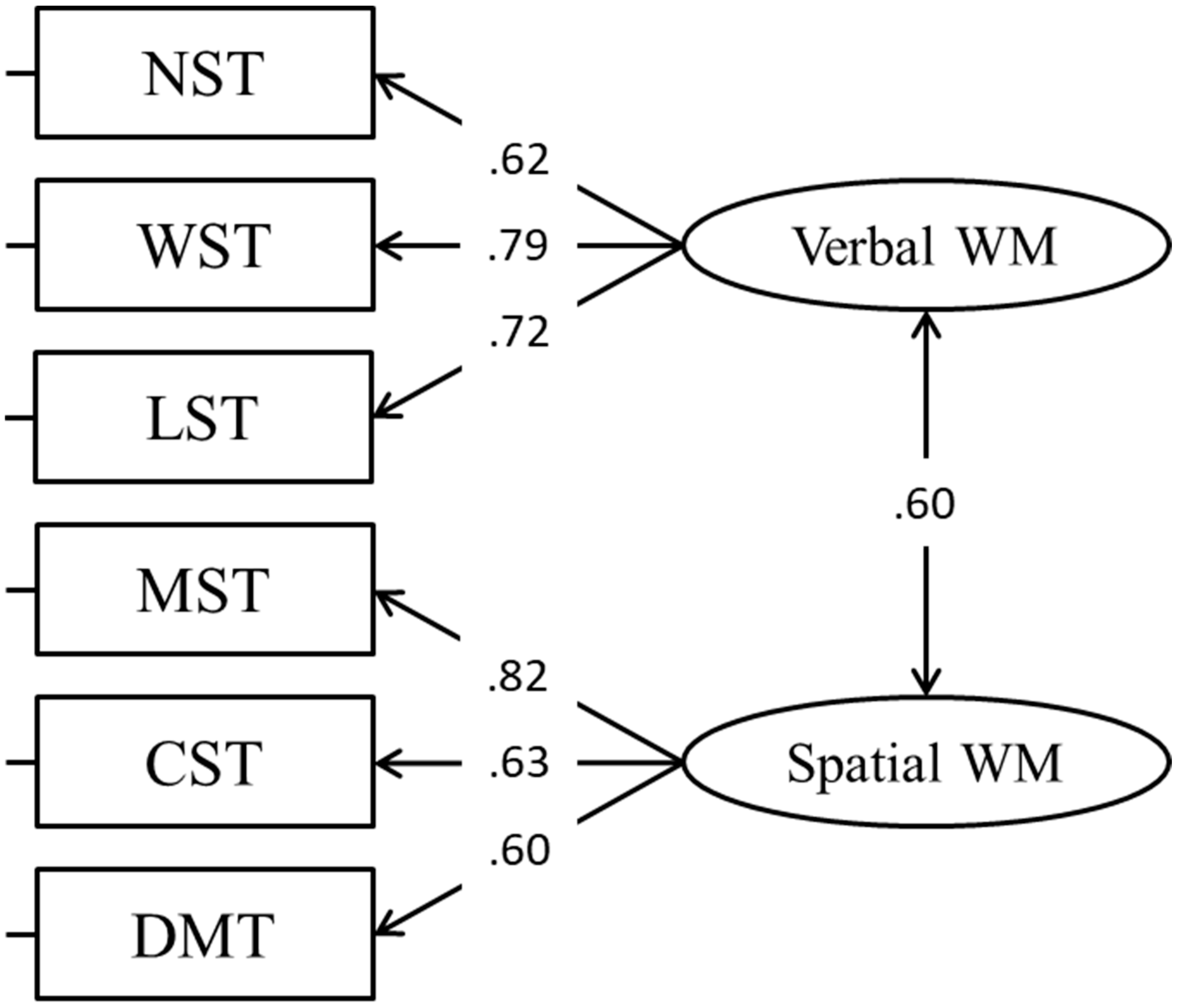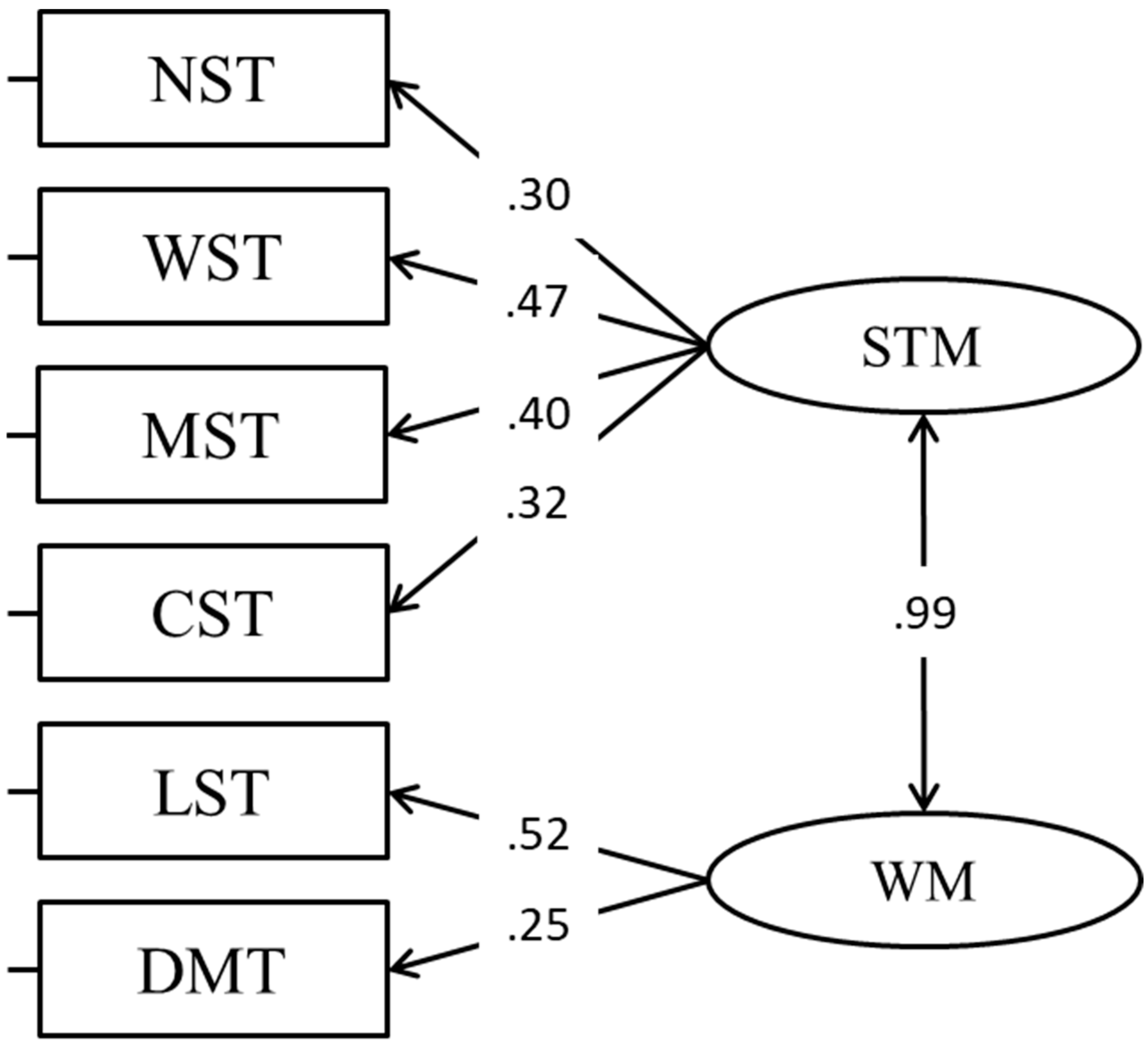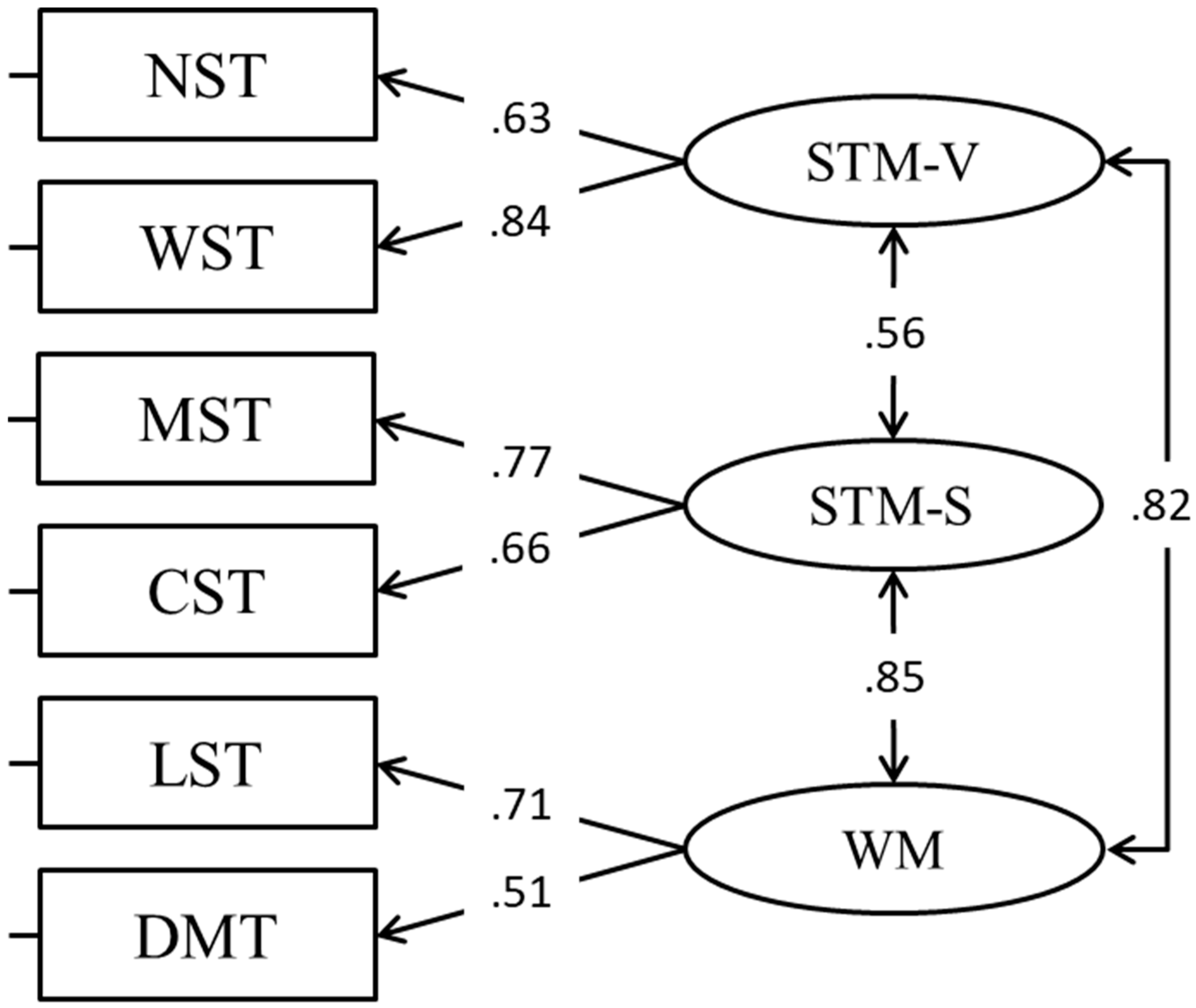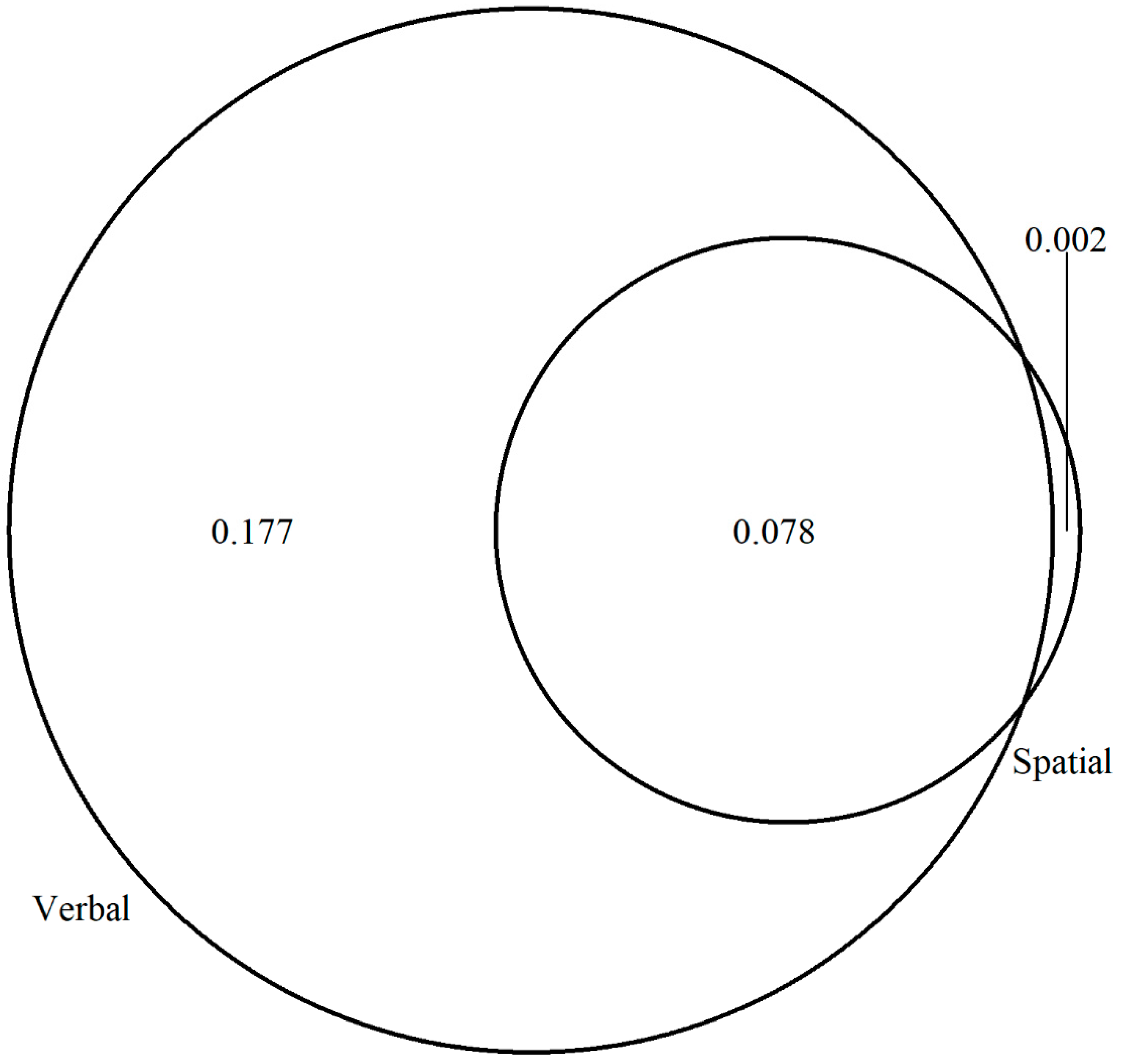The Structure of Working Memory and Its Relationship with Intelligence in Japanese Children
Abstract
:1. Introduction
1.1. The Structure of WM
1.2. Cross-Cultural Difference in WM
1.3. The Relationship between WM and Intelligence
1.4. Aims and Rationale
2. Materials and Methods
2.1. Participants
2.2. Measures
2.2.1. Working Memory
Verbal
Spatial
2.2.2. Intelligence
Fluid Intelligence
Crystallized Intelligence
2.3. Design & Procedure
2.4. Data Analytic Approach
3. Results
3.1. Preliminary Analyses
3.2. Confirmatory Factor Analysis (CFA)
3.2.1. Working Memory
3.2.2. Working Memory and Intelligence
3.3. Variance Partitioning
3.4. Additional Analyses
4. Discussion
5. Conclusions
Author Contributions
Funding
Institutional Review Board Statement
Informed Consent Statement
Data Availability Statement
Conflicts of Interest
References
- Allen, Katie, and David Giofrè. 2021. A Distinction between Working Memory Components as Unique Predictors of Mathematical Components in 7–8 Year Old Children. Educational Psychology 41: 678–94. [Google Scholar] [CrossRef]
- Allen, Katie, David Giofrè, Steve Higgins, and John Adams. 2020. Working Memory Predictors of Mathematics across the Middle Primary School Years. British Journal of Educational Psychology 90: 848–69. [Google Scholar] [CrossRef] [PubMed]
- Allen, Katie, David Giofrè, Steve Higgins, and John Adams. 2021. Using Working Memory Performance to Predict Mathematics Performance 2 Years On. Psychological Research 85: 1986–96. [Google Scholar] [CrossRef] [PubMed]
- Alloway, Tracy Packiam, Susan Elizabeth Gathercole, and Susan J Pickering. 2006. Verbal and Visuospatial Short-Term and Working Memory in Children: Are They Separable? Child Development 77: 1698–716. [Google Scholar] [CrossRef] [PubMed]
- Atkinson, Richard C., and Richard M. Shiffrin. 1968. Human Memory: A Proposed System and Its Control Processes. In Psychology of Learning and Motivation. Cambridge: Academic Press, pp. 89–195. [Google Scholar] [CrossRef]
- Baddeley, Alan D. 1986. Working Memory. Oxford: Oxford University Press, vol. 11. [Google Scholar]
- Baddeley, Alan D. 1992. Working Memory. Science 255: 556–59. [Google Scholar] [CrossRef] [PubMed]
- Baddeley, Alan D. 2003. Working Memory: Looking Back and Looking Forward. Nature Reviews. Neuroscience 4: 829–39. [Google Scholar] [CrossRef] [PubMed]
- Baddeley, Alan D. 2012. Working Memory: Theories, Models, and Controversies. Annual Review of Psychology 63: 1–29. [Google Scholar] [CrossRef]
- Baddeley, Alan D., and Graham Hitch. 1974. Working Memory. In The Psychology of Learning and Motivation: Advances in Research and Theory. Edited by Gordon W. Bower. New York: Academic Press, vol. 8, pp. 47–90. [Google Scholar]
- Bayliss, Donna M., Christopher Jarrold, Deborah M. Gunn, and Alan D. Baddeley. 2003. The Complexities of Complex Span: Explaining Individual Differences in Working Memory in Children and Adults. Journal of Experimental Psychology: General 132: 71–92. [Google Scholar] [CrossRef] [PubMed]
- Buckhalt, Joseph A., Mona El-Sheikh, and Peggy Keller. 2007. Children’s Sleep and Cognitive Functioning: Race and Socioeconomic Status as Moderators of Effects. Child Development 78: 213–31. [Google Scholar] [CrossRef]
- Campos, Isabel S., Leandro S. Almeida, Aristides I. Ferreira, and Luis F. Martinez. 2013. Working Memory as Separable Subsystems: A Study with Portuguese Primary School Children. Spanish Journal of Psychology 16: 1–10. [Google Scholar] [CrossRef]
- Carlson, Stephanie M., and Andrew N. Meltzoff. 2008. Bilingual Experience and Executive Functioning in Young Children. Developmental Science 11: 282–98. [Google Scholar] [CrossRef] [PubMed]
- Carretti, Barbara, David Giofrè, Enrico Toffalini, Cesare Cornoldi, Massimiliano Pastore, and Silvia Lanfranchi. 2022. Structure of Working Memory in Children from 3 to 8 Years Old. Developmental Psychology 58: 1687–701. [Google Scholar] [CrossRef] [PubMed]
- Cattell, Raymond B., and Kren S. Cattell. 1960. Culture Fair Intelligence Test, Scale 2. Champaign: Institute for Personality and Ability Testing. [Google Scholar]
- Colom, Roberto, Carmen Flores-Mendoza, and Irene Rebollo. 2003. Working Memory and Intelligence. Personality and Individual Differences 34: 33–39. [Google Scholar] [CrossRef]
- Conway, Andrew R. A., Michael J. Kane, and Randall W. Engle. 2003. Working Memory Capacity and Its Relation to General Intelligence. Trends in Cognitive Sciences 7: 547–52. [Google Scholar] [CrossRef]
- Cornoldi, Cesare, and David Giofrè. 2014. The Crucial Role of Working Memory in Intellectual Functioning. European Psychologist 19: 260–68. [Google Scholar] [CrossRef]
- Cornoldi, Cesare, and Tomaso Vecchi. 2000. Mental Imagery in Blind People: The Role of Passive and Active Visuo-Spatial Processes. In Touch, Representation and Blindness. Edited by Monika Heller. Oxford: Oxford University Press, pp. 143–81. [Google Scholar]
- Cornoldi, Cesare, and Tomaso Vecchi. 2003. Visuo-Spatial Working Memory and Individual Differences. Hove: Psychology Press. [Google Scholar]
- Daneman, Meredyth, and Patricia A. Carpenter. 1980. Individual Differences in Working Memory and Reading. Journal of Verbal Learning and Verbal Behavior 19: 450–66. [Google Scholar] [CrossRef]
- Demetriou, Andreas, Zhang Xiang Kui, George Spanoudis, Constantinos Christou, Leonidas Kyriakides, and Maria Platsidou. 2005. The Architecture, Dynamics, and Development of Mental Processing: Greek, Chinese, or Universal? Intelligence 33: 109–41. [Google Scholar] [CrossRef]
- Donolato, Enrica, David Giofrè, and Irene C. Mammarella. 2019. Working Memory, Negative Affect and Personal Assets: How Do They Relate to Mathematics and Reading Literacy? Edited by Barbara Dritschel. PLoS ONE 14: e0218921. [Google Scholar] [CrossRef] [PubMed]
- Engle, Randall W., Stephen W. Tuholski, James E. Laughlin, and Andrew R. A. Conway. 1999. Working Memory, Short-Term Memory, and General Fluid Intelligence: A Latent-Variable Approach. Journal of Experimental Psychology: General 128: 309–31. [Google Scholar] [CrossRef]
- Friedman, Naomi P., and Akira Miyake. 2000. Differential Roles for Visuospatial and Verbal Working Memory in Situation Model Construction. Journal of Experimental Psychology: General 129: 61–83. [Google Scholar] [CrossRef]
- Gignac, Gilles E. 2008. Higher-Order Models versus Direct Hierarchical Models: G as Superordinate or Breadth Factor? Psychology Science 50: 21–43. [Google Scholar]
- Gignac, Gilles E. 2016. The Higher-Order Model Imposes a Proportionality Constraint: That Is Why the Bifactor Model Tends to Fit Better. Intelligence 55: 57–68. [Google Scholar] [CrossRef]
- Gignac, Gilles E., and André Kretzschmar. 2017. Evaluating Dimensional Distinctness with Correlated-Factor Models: Limitations and Suggestions. Intelligence 62: 138–47. [Google Scholar] [CrossRef]
- Giofrè, David, and Irene Cristina Mammarella. 2014. The Relationship between Working Memory and Intelligence in Children: Is the Scoring Procedure Important? Intelligence 46: 300–10. [Google Scholar] [CrossRef]
- Giofrè, David, Enrica Donolato, and Irene C. Mammarella. 2018. The Differential Role of Verbal and Visuospatial Working Memory in Mathematics and Reading. Trends in Neuroscience and Education 12: 1–6. [Google Scholar] [CrossRef]
- Giofrè, David, Erika Borella, and Irene Cristina Mammarella. 2017. The Relationship between Intelligence, Working Memory, Academic Self-Esteem, and Academic Achievement. Journal of Cognitive Psychology 5911: 731–47. [Google Scholar] [CrossRef]
- Giofrè, David, Irene Cristina Mammarella, and Cesare Cornoldi. 2013. The Structure of Working Memory and How It Relates to Intelligence in Children. Intelligence 41: 396–406. [Google Scholar] [CrossRef]
- Giofrè, David, Irene Cristina Mammarella, and Cesare Cornoldi. 2014. The Relationship among Geometry, Working Memory, and Intelligence in Children. Journal of Experimental Child Psychology 123: 112–28. [Google Scholar] [CrossRef]
- Gordon, Rebecca, Danila Santana De Morais, Emily Whitelock, and Arzoo Mukarram. 2022. Mapping Components of Verbal and Visuospatial Working Memory to Mathematical Topics in Seven- to Fifteen-year-olds. British Journal of Educational Psychology 92: 1–18. [Google Scholar] [CrossRef]
- Gordon, Rebecca, James H. Smith-Spark, Elizabeth J. Newton, and Lucy A. Henry. 2020. Working Memory and High-Level Cognition in Children: An Analysis of Timing and Accuracy in Complex Span Tasks. Journal of Experimental Child Psychology 191: 104736. [Google Scholar] [CrossRef]
- Gottfredson, Linda. 1997. Mainstream science on intelligence: An editorial with 52 signatories, history, and bibliography. Intelligence 24: 13–23. [Google Scholar] [CrossRef]
- Gray, Shelley, Samuel Green, Mary Alt, T. Hogan, Trudy Kuo, Shara Brinkley, and Nelson Cowan. 2017. The Structure of Working Memory in Young Children and Its Relation to Intelligence. Journal of Memory and Language 92: 183–201. [Google Scholar] [CrossRef] [PubMed]
- Haavisto, Marja-Leena, and Juhani E. Lehto. 2005. Fluid/Spatial and Crystallized Intelligence in Relation to Domain-Specific Working Memory: A Latent-Variable Approach. Learning and Individual Differences 15: 1–21. [Google Scholar] [CrossRef]
- Horn, John L., and Raymond B. Cattell. 1966. Refinement and Test of the Theory of Fluid and Crystallized General Intelligences. Journal of Educational Psychology 57: 253–70. [Google Scholar] [CrossRef]
- Hornung, Caroline, Martin Brunner, Robert A. P. Reuter, and Romain Martin. 2011. Children’s Working Memory: Its Structure and Relationship to Fluid Intelligence. Intelligence 39: 210–21. [Google Scholar] [CrossRef]
- Hu, Li-tze, and Peter M. Bentler. 1998. Fit Indices in Covariance Structure Modeling: Sensitivity to Underparameterized Model Misspecification. Psychological Methods 3: 424–53. [Google Scholar] [CrossRef]
- Inoue, Tomohiro, George K. Georgiou, Naoko Muroya, Hisao Maekawa, and Rauno Parrila. 2017. Cognitive Predictors of Literacy Acquisition in Syllabic Hiragana and Morphographic Kanji. Reading and Writing 30: 1335–60. [Google Scholar] [CrossRef]
- Kane, Michael J., David Z. Hambrick, Stephen W. Tuholski, Oliver Wilhelm, Tabitha W. Payne, and Randall W. Engle. 2004. The Generality of Working Memory Capacity: A Latent-Variable Approach to Verbal and Visuospatial Memory Span and Reasoning. Journal of Experimental Psychology: General 133: 189–217. [Google Scholar] [CrossRef]
- Kyllonen, Patrick C. 2002. G: Knowledge, Speed, Strategies, or Working-Memory Capacity? A Systems Perspective. In The General Factor of Intelligence: How General Is It? Edited by Robert J. Sternberg and Elena L. Grigorenko. New York: Psychology Press, pp. 415–45. [Google Scholar] [CrossRef]
- Lan, Xuezhao, Cristine H. Legare, Claire Cameron Ponitz, Su Li, and Frederick J. Morrison. 2011. Investigating the Links between the Subcomponents of Executive Function and Academic Achievement: A Cross-Cultural Analysis of Chinese and American Preschoolers. Journal of Experimental Child Psychology 108: 677–92. [Google Scholar] [CrossRef]
- Lanfranchi, Silvia, Cesare Cornoldi, and Renzo Vianello. 2004. Verbal and Visuospatial Working Memory Deficits in Children with Down Syndrome. American Journal of Mental Retardation: AJMR 109: 456–66. [Google Scholar] [CrossRef]
- Mammarella, Irene Cristina, and Cesare Cornoldi. 2005. Sequence and Space: The Critical Role of a Backward Spatial Span in the Working Memory Deficit of Visuospatial Learning Disabled Children. Cognitive Neuropsychology 22: 1055–68. [Google Scholar] [CrossRef]
- Mammarella, Irene Cristina, Cesare Cornoldi, Francesca Pazzaglia, Cristina Toso, Mario Grimoldi, and Claudio Vio. 2006. Evidence for a Double Dissociation between Spatial-Simultaneous and Spatial-Sequential Working Memory in Visuospatial (Nonverbal) Learning Disabled Children. Brain and Cognition 62: 58–67. [Google Scholar] [CrossRef] [PubMed]
- Mammarella, Irene Cristina, Sara Caviola, David Giofrè, and Dénes Szűcs. 2018. The Underlying Structure of Visuospatial Working Memory in Children with Mathematical Learning Disability. British Journal of Developmental Psychology 36: 220–35. [Google Scholar] [CrossRef]
- Michalczyk, Kurt, Nadine Malstädt, Maria Worgt, Tanja Könen, and Marcus Hasselhorn. 2013. Age Differences and Measurement Invariance of Working Memory in 5- to 12-Year-Old Children. European Journal of Psychological Assessment 29: 220–29. [Google Scholar] [CrossRef]
- Miyake, Akira, Naomi P. Friedman, David A. Rettinger, Priti Shah, and Mary Hegarty. 2001. How Are Visuospatial Working Memory, Executive Functioning, and Spatial Abilities Related? A Latent-Variable Analysis. Journal of Experimental Psychology: General 130: 621. [Google Scholar] [CrossRef] [PubMed]
- Muroya, Naoko, Tomohiro Inoue, Miyuki Hosokawa, George K. Georgiou, Hisao Maekawa, and Rauno Parrila. 2017. The Role of Morphological Awareness in Word Reading Skills in Japanese: A Within-Language Cross-Orthographic Perspective. Scientific Studies of Reading 21: 449–62. [Google Scholar] [CrossRef]
- Oh, Seungmi, and Charlie Lewis. 2008. Korean Preschoolers’ Advanced Inhibitory Control and Its Relation to Other Executive Skills and Mental State Understanding. Child Development 79: 80–99. [Google Scholar] [CrossRef] [PubMed]
- R Core Team. 2022. R: A Language and Environment for Statistical Computing. Vienna: R Foundation for Statistical Computing. [Google Scholar]
- Roos, Leslie E., Kathryn G. Beauchamp, Jessica Flannery, and Philip A. Fisher. 2017. Cultural Contributions to Childhood Executive Function. Journal of Cognition and Culture 8: 61. [Google Scholar]
- Rosseel, Yves. 2012. Lavaan: An R Package for Structural Equation Modeling. Journal of Statistical Software 48: 1–36. [Google Scholar] [CrossRef]
- Shu, Hua, Xi Chen, Richard C. Anderson, Ningning Wu, and Yue Xuan. 2003. Properties of School Chinese: Implications for Learning to Read. Child Development 74: 27–47. [Google Scholar] [CrossRef]
- Tanaka, Makiro, Masao Aizawa, Tatsuya Saito, Hisako Tanahashi, Asuko Kondo, Akihiro Kawauchi, Kazufumi Suzuki, and Yoshiko Hirayama. 2011. Development and Utilization of Vocabulary Lists, Kanji Lists, and Other Resources Based on Corpora for Effective Language Policy (Report No. LR-CCG-10-07). Tokyo: National Institute for Japanese Language and Linguistics. [Google Scholar] [CrossRef]
- Unsworth, Nash, and Randall W. Engle. 2006. Simple and Complex Memory Spans and Their Relation to Fluid Abilities: Evidence from List-Length Effects. Journal of Memory and Language 54: 68–80. [Google Scholar] [CrossRef]
- Unsworth, Nash, and Randall W. Engle. 2007. On the Division of Short-Term and Working Memory: An Examination of Simple and Complex Span and Their Relation to Higher Order Abilities. Psychological Bulletin 134: 16–28. [Google Scholar] [CrossRef] [PubMed]
- Wechsler, D., and Japanese WISC-IV Publication Committee. 2010. Japanese Version of the Wechsler Intelligence Scale for Children, 4th ed. Tokyo: Nihon Bunka Kagaku. [Google Scholar]
- Zhang, Yuxin, Andrew Tolmie, and Rebecca Gordon. 2022. The Relationship between Working Memory and Arithmetic in Primary School Children: A Meta-Analysis. Brain Sciences 13: 22. [Google Scholar] [CrossRef]
- Zinbarg, Richard E., William Revelle, and Iftah Yovel. 2007. Estimating ω h for Structures Containing Two Group Factors: Perils and Prospects. Applied Psychological Measurement 31: 135–57. [Google Scholar] [CrossRef]








| 1 | 2 | 3 | 4 | 5 | 6 | 7 | 8 | 9 | 10 | |
|---|---|---|---|---|---|---|---|---|---|---|
| 1. NST | ― | 0.61 | 0.55 | 0.40 | 0.39 | 0.33 | 0.35 | 0.35 | 0.41 | 0.40 |
| 2. WST | 0.53 | ― | 0.66 | 0.51 | 0.43 | 0.38 | 0.37 | 0.38 | 0.42 | 0.43 |
| 3. LST | 0.41 | 0.56 | ― | 0.56 | 0.54 | 0.56 | 0.53 | 0.52 | 0.57 | 0.59 |
| 4. MST | 0.25 | 0.38 | 0.38 | ― | 0.62 | 0.63 | 0.45 | 0.45 | 0.41 | 0.44 |
| 5. CST | 0.25 | 0.29 | 0.37 | 0.51 | ― | 0.51 | 0.46 | 0.43 | 0.40 | 0.40 |
| 6. DMT | 0.15 | 0.20 | 0.36 | 0.50 | 0.36 | ― | 0.41 | 0.38 | 0.37 | 0.44 |
| 7. Cattel A | 0.23 | 0.25 | 0.41 | 0.33 | 0.34 | 0.27 | ― | 0.76 | 0.41 | 0.49 |
| 8. Cattell B | 0.26 | 0.29 | 0.44 | 0.36 | 0.34 | 0.27 | 0.74 | ― | 0.31 | 0.39 |
| 9. Vocabulary | 0.21 | 0.22 | 0.31 | 0.14 | 0.15 | 0.06 | 0.24 | 0.16 | ― | 0.70 |
| 10. Similarities | 0.19 | 0.21 | 0.33 | 0.16 | 0.14 | 0.14 | 0.35 | 0.26 | 0.48 | ― |
| M | 32.15 | 26.39 | 12.36 | 43.92 | 40.79 | 14.56 | 26.79 | 27.16 | 20.41 | 15.82 |
| SD | 5.74 | 8.09 | 6.09 | 14.25 | 10.5 | 6.07 | 6.22 | 6.61 | 7.43 | 5.55 |
| Skew | −0.42 | 0.62 | 0.15 | −0.06 | −0.32 | −0.04 | −0.27 | −0.59 | 0.90 | 0.34 |
| Kurtosis | −0.55 | 0.82 | −0.73 | −0.16 | −0.15 | −0.96 | −0.18 | −0.14 | 0.49 | −0.73 |
| χ2 | df | p | RMSEA | SRMR | CFI | NNFI | AIC | |
|---|---|---|---|---|---|---|---|---|
| CFA | ||||||||
| WM | ||||||||
| Model 1 | 56.84 | 9 | 0.000 | 0.177 | 0.086 | 0.819 | 0.699 | 6643 |
| Model 2 | 13.41 | 8 | 0.099 | 0.063 | 0.043 | 0.980 | 0.962 | 6601 |
| Model 3 | 56.84 | 8 | 0.000 | 0.190 | 0.086 | 0.815 | 0.654 | 6645 |
| Model 4 | 28.87 | 6 | 0.000 | 0.150 | 0.063 | 0.914 | 0.784 | 6621 |
| Model 5 | 6.51 | 4 | 0.164 | 0.061 | 0.023 | 0.991 | 0.964 | 6603 |
| WM & g | ||||||||
| Model 6 | 33.16 | 29 | 0.271 | 0.029 | 0.039 | 0.992 | 0.987 | 10,592 |
| MG-CFAs | ||||||||
| Model 1 | 24.27 | 16 | 0.084 | 0.078 | 0.050 | 0.969 | 0.942 | 6633 |
| Model 2 | 29.95 | 20 | 0.071 | 0.077 | 0.071 | 0.963 | 0.944 | 6631 |
| Model 3 | 36.58 | 26 | 0.081 | 0.069 | 0.089 | 0.961 | 0.954 | 6625 |
Disclaimer/Publisher’s Note: The statements, opinions and data contained in all publications are solely those of the individual author(s) and contributor(s) and not of MDPI and/or the editor(s). MDPI and/or the editor(s) disclaim responsibility for any injury to people or property resulting from any ideas, methods, instructions or products referred to in the content. |
© 2023 by the authors. Licensee MDPI, Basel, Switzerland. This article is an open access article distributed under the terms and conditions of the Creative Commons Attribution (CC BY) license (https://creativecommons.org/licenses/by/4.0/).
Share and Cite
Ikeda, Y.; Kita, Y.; Oi, Y.; Okuzumi, H.; Lanfranchi, S.; Pulina, F.; Mammarella, I.C.; Allen, K.; Giofrè, D. The Structure of Working Memory and Its Relationship with Intelligence in Japanese Children. J. Intell. 2023, 11, 167. https://doi.org/10.3390/jintelligence11080167
Ikeda Y, Kita Y, Oi Y, Okuzumi H, Lanfranchi S, Pulina F, Mammarella IC, Allen K, Giofrè D. The Structure of Working Memory and Its Relationship with Intelligence in Japanese Children. Journal of Intelligence. 2023; 11(8):167. https://doi.org/10.3390/jintelligence11080167
Chicago/Turabian StyleIkeda, Yoshifumi, Yosuke Kita, Yuhei Oi, Hideyuki Okuzumi, Silvia Lanfranchi, Francesca Pulina, Irene Cristina Mammarella, Katie Allen, and David Giofrè. 2023. "The Structure of Working Memory and Its Relationship with Intelligence in Japanese Children" Journal of Intelligence 11, no. 8: 167. https://doi.org/10.3390/jintelligence11080167





